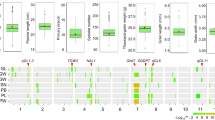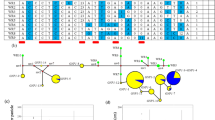Abstract
Comparative sequencing of GS3, the most important grain length (GL) QTL, has shown that differentiation of rice GL might be principally due to a single nucleotide polymorphism (SNP) between C and A in the second exon. A total of 180 varieties representing a wide range of rice germplasm were used for association analysis between C–A mutation and GL in order to confirm the potential causal mutation. A cleaved amplified polymorphic sequence (CAPS) marker, SF28, was developed based on the C–A polymorphism in the GS3 gene. A total of 142 varieties carried allele C with GL from 6.4 to 8.8 mm, while the remaining 38 varieties carried allele A with GL from 8.8 to 10.7 mm. Twenty-four unlinked SSR markers were selected to genotype 180 varieties for population structure analysis. Population structure was observed when the population was classified to three subpopulations. Average GL of either genotype A or genotype C within japonica among the three subpopulations had no significant difference from that in indica, respectively, although indica rice had longer grains on average than japonica in the 180 varieties. However, genotype C always had longer grain length on average than genotype A among three subpopulations. The mutation could explain 79.1, 66.4 and 34.7% of GL variation in the three subpopulations, respectively. These results clearly confirmed the mutation between C and A was highly associated with GL. The SF28 could be a functional marker for improvement of rice grain length.



Similar content being viewed by others
References
Aluko G, Martinez C, Tohme J, Castano C, Bergman C, Oard HJ (2004) QTL mapping of grain quality traits from the interspecific cross Oryza sativa × O. glaberrima. Theor Appl Genet 109:630–639
Amarawathi Y, Singh R, Singh AK, Singh VP, Mohapatra T, Sharma TR, Singh NK (2008) Mapping of quantitative trait loci for basmati quality traits in rice (Oryza sativa L.). Mol Breeding 21:49–65
Bassam BJ, Anolles GC, Gresshoff PM (1991) Fast and sensitive silver staining of DNA in polyacrylamide gels. Anal Biochem 196:80–83
Bormans CA, Richard RB, Kephart DD, McClung AM, Park WD (2002) Analysis of a single nucleotide polymorphism that controls the cooking quality of rice using a non-gel based assay. Euphytica 128:261–267
Ellis MH, Spielmeyer W, Gale KR, Rebetzke GJ, Richards RA (2002) “Perfect” markers for the Rht-B1b and Rht-D1b dwarfing genes in wheat. Theor Appl Gene 105:1038–1042
Fan CC, Xing YZ, Mao HL, Lu TT, Han B, Xu CG, Li XH, Zhang QF (2006) GS3, a major QTL for grain length and weight and minor QTL for grain width and thickness in rice, encodes a putative transmembrane protein. Theor Appl Genet 112:1164–1171
Gut IG (2001) Automation in genotyping single nucleotide polymorphisms. Hum Mutat 17:475–492
Huang N, Parco A, Mew T, Magpantay G, McCouch S, Guiderdoni E, Xu JC, Subudhi P, Angeles ER, Khush GS (1997) RFLP mapping of isozymes, RAPD, and QTLs for grain shape, brown planthopper resistance in a doubled-haploid rice population. Mol Breed 3:105–113
Iyer-Pascuzzi AS, McCouch SR (2007) Functional markers for xa5-mediated resistance in rice (Oryza sativa, L.). Mol Breed 19:291–296
Andersen JR, Lübberstedt T (2003) Functional markers in plants. Trends plant sci 8:554–560
Juliano BO, Villareal CP (1993) Grain quality evaluation of world rice. International Rice Research Institute, Manila
Kim S, Ruparel HD, Gilliam TC, Ju JY (2003) Digital genotyping using molecular affinity and mass spectrometry. Nat Rev Genet 4:1001–1008
Li J, Thomson M, McCouch SR (2004) Fine mapping of a grain-weight quantitative trait locus in the pericentrometric region of rice chromosome 3. Genetics 168:2187–2195
Li ZC, Zhang HL, Cao YS, Qiu ZE, Wei XH, Tang SX, Yu P, Wang XK (2003) Studies on the sampling strategy for primary core collection of Chinese ingenious rice. Acta Agron Sin 29:20–24
Liu J, Van Eck J, Cong B, Tanksley SD (2002) A new class of regulatory genes underlying the cause of pear-shaped tomato fruit. Proc Natl Acad Sci USA 99:13302–13306
Luo YK, Zhu ZW, Chen N, Duan BW, Zhang LP (2004) Grain types and related quality characteristics of rice in China. Chinese J Rice Sci 18:135–139
Louis MTB, Robert JH, Jin QS, Russell FR, Daniel LEW (2005) A perfect marker for fragrance genotyping in rice. Mol Breed 16:279–283
McKenzie KS, Rutger JN (1983) Genetic analysis of amylose content, alkali spreading score, and grain dimensions in rice. Crop Sci 23:306–313
Murray MG, Thompson WF (1980) Rapid isolation of high molecular weight plant DNA. Nucleic Acids Res 8:4321–4325
Paterson AH, Lin YR, Li ZK, Schertz KF, Doebley JF, Pinson SRM, Liu SC, Stansel JW, Irvine JE (1995) Convergent domestication of cereal crops by independent mutations at corresponding genetic loci. Science 269:1714–1718
Peng J, Richards DE, Hartley NM, Murphy GP, Devos KM, Flintham JE, Beales J, Fish LJ, Worland AJ, Pelica F, Sudhakar D, Christou P, Snape JW, Gale MD, Harberd NP (1999) ‘Green revolution’ genes encode mutant gibberellin response modulators. Nature 400:256–261
Peter E, Brian R, Graham S (2004) Allele-specific markers within the barley stem rust resistance gene (Rpg1). Barley Genet Newsl 33:7
Princhard JK, Stephens M, Donnelly P (2000) Inference of population structure using multilocus genotype data. Genetics 155:945–959
Rafalski JA, Tingey SV (1993) Genetic diagnostics in plant breeding: RAPDs, microsatellites and machines. Trends Genet 9:275–280
Redoña ED, Mackill DJ (1998) Quantitative trait locus analysis for rice panicle and grain characteristics. Theor Appl Genet 96:957–963
Sano R, Morishima H (1992) Indica-Japonica differentiation of rice cultivars viewed from variation in key characters and isozymes with special reference to landraces from the Himalayan hilly areas. Theor Appl Genet 84:266–274
Takahashi Y, Shomura A, Sasaki T, Yano M (2001) Hd6, a rice quantitative trait locus involved in photoperiod sensitivity, encodes the subunit of protein kinase CK2. Proc Natl Acad Sci 98:7922–7927
Tan YF, Xing YZ, Li JX, Yu SB, Xu CG, Zhang Q (2000) Genetic bases of appearance quality of rice grains in Shanyou 63, an elite rice hybrid. Theor Appl Genet 101:823–829
Temnykh S, DeCklerck G, Lukashova A, Lipovich L, Cartinhiur S, McCouch S (2001) Computational and experimental analysis of microsatellites in rice (Oryza sativa L.): frequency, length variation, transposon associations, and genetic marker potential. Genome Res 11:1441–1452
Toshiyuki K, Shizo O, Nobuhiko M, Yoshimitsu T, Yoshiki K, Shoichi S, Yukoh H, Hidemasa I, Naoto N (2003) Map-based cloning of a fertility restorer gene, Rf-1, in rice (Oryza sativa L.). Plant J 37:315–325
Unnevehr LJ, Duff B, Juliano BO (1992) Consumer demand for rice grain quality. International Rice Research Institute, Manila, and International Development Research Center, Ottawa
Wan XY, Wan JM, Weng JF, Jiang L, Bi JC, Wang CM, Zhai HQ (2005) Stability of QTLs for rice grain dimension and endosperm chalkiness characteristics across eight environments. Theor Appl Genet 110:1334–1346
Xing YZ, Tan YF, Xu CG, Hua JP, Sun XL (2001) Mapping quantitative trait loci for grain appearance traits of rice using a recombinant inbred line population. Acta Bot Sin 43:840–845
Acknowledgments
This work was supported in part by grants from the National Program on the Development of Basic Research, National Program on the Development of Hi-tech Research (2007AA10Z103) and the National Natural Science Foundation of China.
Author information
Authors and Affiliations
Corresponding author
Additional information
Communicated by Y. Xu.
Rights and permissions
About this article
Cite this article
Fan, C., Yu, S., Wang, C. et al. A causal C–A mutation in the second exon of GS3 highly associated with rice grain length and validated as a functional marker. Theor Appl Genet 118, 465–472 (2009). https://doi.org/10.1007/s00122-008-0913-1
Received:
Accepted:
Published:
Issue Date:
DOI: https://doi.org/10.1007/s00122-008-0913-1




